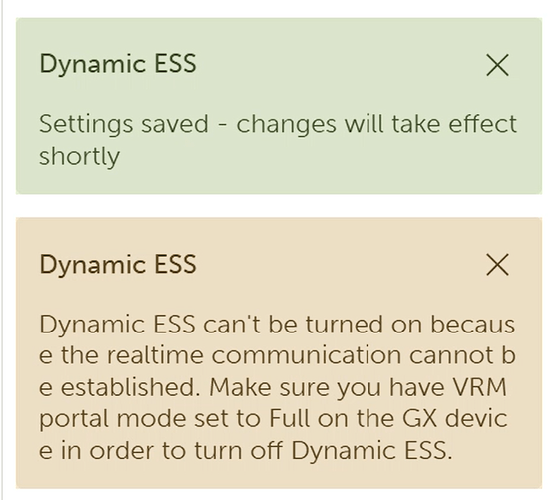This is a dedicated section for general DESS discussion - issues, requests etc.
Dynamic ESS on VRM
Dynamic ESS is live on VRM!
2024-05-07: Make sure to check https://community.victronenergy.com/articles/283506/dynamic-ess-green-mode.html too.
What is Dynamic ESS?
Dynamic ESS is an algorithm that aims to minimize the costs made on the grid and battery. It does this by taking several factors into account. First of all the energy price that, in case of a dynamic energy contract, changes every hour. Then it also looks at the solar and consumption forecast. Together with the grid limitations and battery costs and specifications it creates a schedule for the system that determines when to (dis)charge the battery.
Note that the system is not limited to dynamic contracts; it also works for systems that have a fixed pricing scheme.
What do I need to use Dynamic ESS?
Dynamic ESS is only eligible for the installations which fits the following criteria:
- Be an ESS;
- Not use Generator connection outside of power outages;
- Has 2-way communication enabled
- Run Venus OS version 3.30 (or newer)
For best results:
- Have a variable or dynamic energy contract.
- Use a supported energy meter (especially if your system setup has heavy loads (EV charger, heat pumps) in front of the Victron system). See here for more information on this.
How can I configure it?
If your site has an ESS, the menu option to configure Dynamic ESS for your site will show. There is a configuration menu that you will need to fill out, before you can actually use it. While we tried to make it as easy as possible, you are likely to do some research in order to fill out all the questions. For instance, you will need to know your battery capacity and the amount of kilowatts it is capable of (dis)charging in an hour. But you will also need to know the formulas that build up the actual price that you pay for buying energy from and selling to the grid. These formulas are not the most straightforward thing to find as the info needed for it is usually somewhere in your energy providers contract.
We provide some example formulas in the dropdown, but that is no guarantee that it matches your actual contract. You need to check that yourself. The manual also gives some examples on how to take the step from your contract to the right formula.
Known limitations
After this go-live, we will continuously improve Dynamic ESS.
Some of the things on our todo list:
- Maximizing battery charge by the end of the day to cover consumption until sunrise
- Periodically fully charge the battery to improve battery life
- Adding support for varying service fees based on the time of day
- Allowing users to enter a fixed schedule for grid-battery restrictions
- Supporting fixed prices that change on the half-hour instead of the whole hour
- Introducing (smart) support for high-consumption loads such as EV charging and heat pumps
More information
If you need more information, check out the manual. There has already been a lot of discussions on the beta implementation in the comments of five previous articles.
As always, we appreciate your feedback. Feel free to let us know how to improve, and thank you for being part of the development journey. To streamline communication, older posts are closed for comments, and any new feedback can be provided in this post.
When reporting a possible issue, please also mention your VRM URL or dashboard number.






